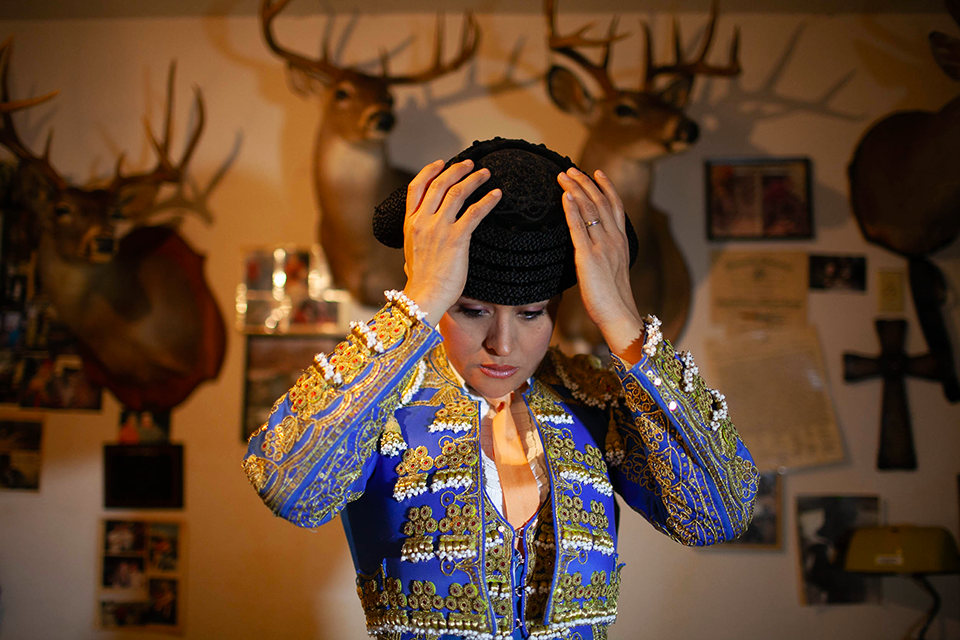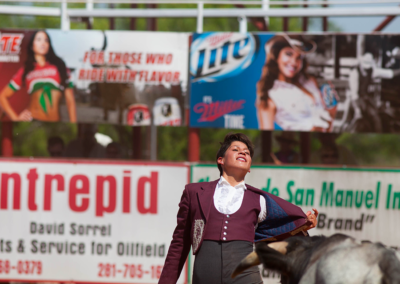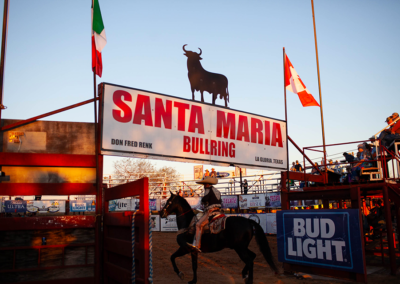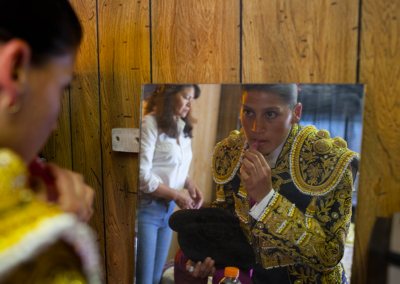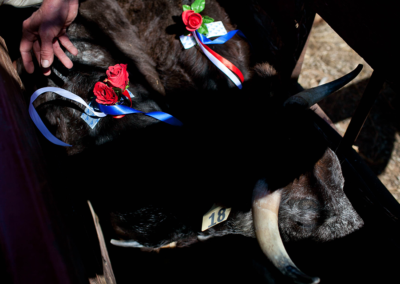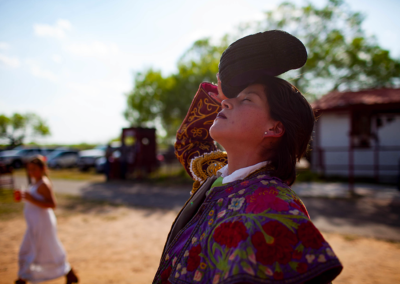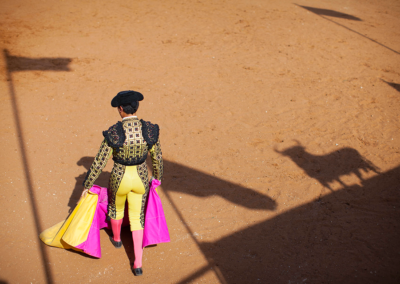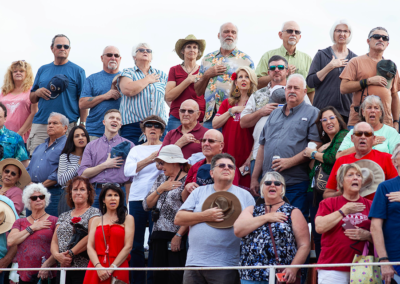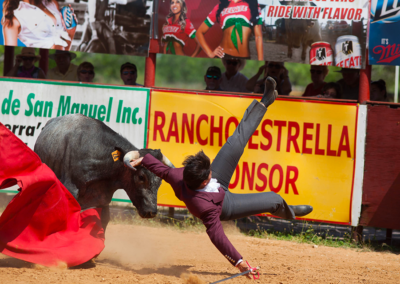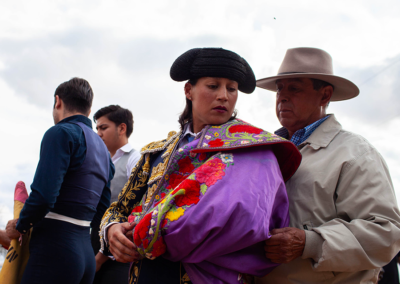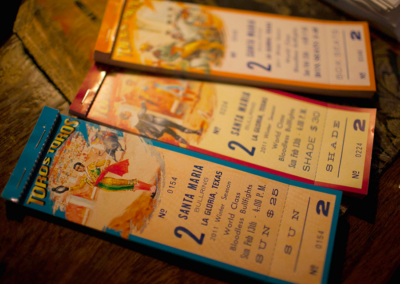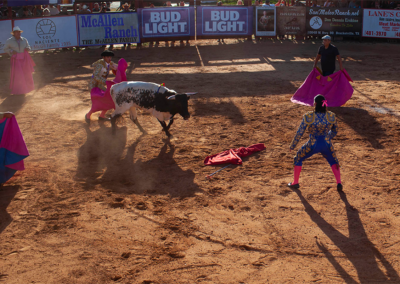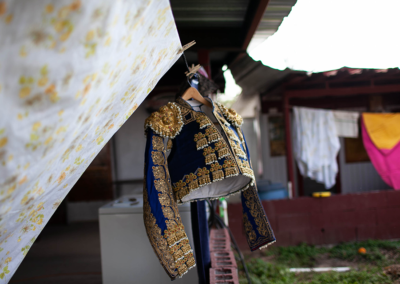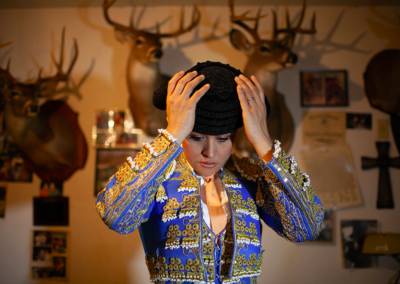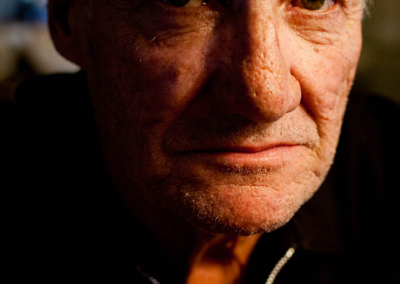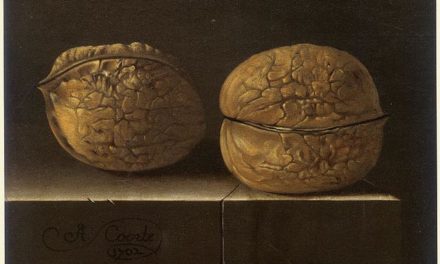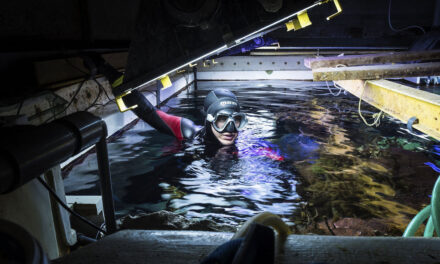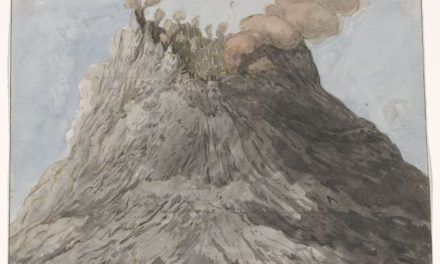Bloodless
by Katie Hayes Luke
Interview by Melissa Palleschi
With a population of under 100 and sprawling brushland as far as the eye can see, La Gloria, Texas, is as in the middle of nowhere as it gets. In 2008, looking for a story along the Texas-Mexico border, Katie Hayes Luke set out to visit this town to meet Fred Renk on his ranch called La Querencia. Once an aspiring matador, Fred was recruiting and training future bullfighters from Mexico to fight in bloodless matches in a ring he’d built in 2000 on his 65-acre ranch.
Unlike traditional bullfights, the kill is symbolic in bloodless bullfighting, represented by a rose attached to the bull’s back with Velcro.
We talked to Katie about her time on the ranch, the female bullfighters she met, and how bloodless bullfights became a part of her own family’s tradition.
Karla Santoyo faces a bull in the ring. She explains that while she loves the adrenaline rush, she is always nervous before a fight. Her beauty draws large crowds, but once she steps into the ring, she must rely solely on her physical strength and training. July 2, 2016.
Karla Santoyo, a headliner at Santa Maria Bullring says that bullfighting is ‘a little bit complicated for a woman because it’s a world of men.’ Here, Karla prepares for her turn in the Santa Maria Bullring. February 8, 2015.
David Renk attaches flowers to the back of the bulls before a fight. To be considered a successful fight, the matador(a) must pull the flower from the back of the bull to symbolize a clean kill. February 13, 2011.
Before her fight at the Santa Maria Bullring, Karla Santoyo adjusts her manta, or hat. February 26, 2017.
The crowd, a mix of locals and winter Texans, the snowbirds who migrate south in the colder months, flock to the Santa Maria Bullring to see the young aspiring bullfighters. February 16, 2016.
Karla Santoyo and her father, Paco Santoyo, prepare before Karla enters the bullring. February 16, 2020.
A veterinarian, Karla treats the bulls on her family ranch in Aguascalientes, Mexico when she is not fighting them in a bullring. Here, she recovers after being knocked down. June 28, 2020.
Lupita Lopez’s jacket hangs on the line outside Renk’s house at La Querencia ranch in south Texas. Renk, her benefactor, helped to raise money for the purchase of her bullfighter’s uniform, the traje de luces (“suit of lights”). January 23, 2011.
Fourth-generation bullfighter Lupita Lopez, from Merida, Mexico, carries on a proud family tradition of bullfighting. While she faces the same dangers as the bullfighting men in her family, she faces a host of other challenges as one of only four women of her rank in the world. January 16, 2008.
What first sparked your interest in bloodless bullfighting and female matadors in particular?
I am from Texas, so I am familiar with Texas culture. I had a mom who loved to travel, and, as a kid, we’d cross the border to go down into Mexico. And then, when I was in graduate school, I began thinking of interesting feature stories that I could do. I wanted to look at the intermixing of cultures along the southern border. I was interested in the porous nature of the border, particularly with regard to culture.
At first, I was thinking bullfighting is all over in Mexico, but you don’t hear about it in Texas. There must be a kid who’s training to be a matador in southern Texas and who may be going across the border to train and coming back. That was what my brain was on, and I just started researching ideas. I was looking for young kids along the Texas border that might be learning how to bullfight and traveling to the Mexico side of the border. What I came across was Fred’s ranch. And it was kind of a different story encapsulated within that same idea of a blending of cultures.
Fred’s American and a Korean War veteran. When he came back, he said all he wanted to do was fight bulls. Fred’s what they call an aficionado, someone who loves bullfighting but is not a professional. He fought bulls and then trained his son David Renk who ended up becoming a full matador.
Later in life, they built a bullring in Fred’s backyard. He literally has a house, a carport, a little bar, and this bullring on his ranch.
So, just like in his backyard?
Yeah, it’s very cool. There is a lounge with a bar. From some of the pictures, you can see that it’s decorated with bullfighting memorabilia and newspaper clippings and photos. Anybody who’s fought bulls in south Texas or is part of the culture down there, Fred has pictures with them. And, when you step outside his house, there’s his bullring.
How did you end up in La Gloria?
I basically cold-called Fred and said, hey, I am interested, and I’d love to come down. At the time, Fred had a bullfighting school and put on bloodless bullfights in his ring. Once a year, he would host an event for bullfighting enthusiasts, also called aficionados, to come to his ranch and then travel to Mexico to participate in and/or watch a bullfight. This was the first event I went to, and the project evolved from there.
Most of my work was just going down to photograph the events on his ranch. He’d have matadors come up from Mexico. So, I just happened to be there when Lupita Lopez started fighting, and I thought, whoa, that’s a really cool idea. There were only four female matadors in the whole world at the time. Lupita was still in training, but she eventually became a full matador in Mexico in 2009.
How many years have you been doing it now?
I started in 2008 until right before COVID. There was a fight in February 2020. If I’d had a baby, I would miss a season. The season runs from January to March, and Fred would put on 4-6 fights, so I knew I could run down two to three times a year to take photographs. I’d prioritize if Lupita or Karla were there. Some years there were no women, so I’d photograph the men too.
Apart from the absence of bloodshed, are there any other differences between bloodless fights and the traditional corridas still held in Mexico and Spain?
In Mexico and Spain, there are picadors who stab the bull’s back ahead of time, so there is some bleeding of the bull before a fight. With these bulls, none of that is happening. The bulls come in from their corral, a flower is put on their back, and they’re sent out into the ring. But the rest of it, Fred tries as much as possible to keep similar because he thinks of it as an art form. He wants to show the crowd this other style. And, so, while the event is going on, Fred is narrating what’s happening. He is saying, and this is where the bullfighter does this, and the bull is reacting in this way. It’s a teaching moment because most people who come to see the bullfights don’t know much about them or have seen one before.
What sort of crowds does the Santa Maria bullring draw when headlined by female matadors?
The crowds were larger if there was a female matador. I think more people were interested. A few different groups of people come to the events. One is the local community, but there are also many snowbirds from Canada and the northern US who come to south Texas during wintertime. For a lot of them, it’s really novel. They are not used to seeing a bullfight, they don’t know much about it, and then there is also a female bullfighter. So I think it does add an extra incentive for people to come.
How did your relationship evolve with the women you photographed?
Just being a fly on the wall is kind of how I approach stuff. Over time they got more comfortable and familiar with me. So, if I showed up and was like, hey can I photograph you while you get dressed, they would say yes. But, I think they’re also really used to working with photographers, so having someone take pictures of them was nothing foreign. They knew I would be there and that I would send them photos. I wouldn’t say I have a deep relationship with Lupita and Karla, but they expect to see me there taking pictures if they are fighting.
What’s happened with the project since the pandemic?
Well, Fred’s in his eighties. In 2020 he was going to retire. He said he was tired of producing the events, and maybe his grandson would take over. They haven’t had any fights since COVID hit. I’ve talked to Fred [recently], and he said they were considering putting on more events this year. I think they have a fight scheduled in January. I’ll probably go down for that one.
In my mind, I feel like I am done with the project, but I will go because I am close to them. I always bring my camera. It’s something my kids have grown up going to. I have pictures of all my kids. I’ll get to bring Oliver, who is my littlest, with me, and get to say he got to go to a bullfight too.
So you felt comfortable bringing your kids?
Oh, yeah.
You didn’t feel it was too much for them?
There is nothing that I feel is cruel or mean. If you look at the Instagram comments on the NPR story, there’s a lot of people who are really mad. I know that people feel differently about the issue, but I felt like Fred was doing it respectfully, and the bull is not getting harmed.
I felt fine bringing my kids—it’s a fun event. Fred has mariachis there and food. He’s also taught little kids. He’d have schools come out and play in the bullring and stuff. I would hesitate to take my kids to an actual bullfight in Mexico and Spain just because I don’t know how I would feel with the bull dying in the end.
I started the project before I had kids, and my boyfriend (who became my husband) would go to the events with me. It’s been like a family thing for so long. And Fred’s so welcoming. My mom would go and watch the kids while I photographed. I’ve had infants there photographing, hanging on to me in a pouch. It’s so laid back and almost family now.
You’ve been doing this for quite a number of years. Are there any standout or memorable moments for you?
Oh gosh, there are a lot of them. One that’s not necessarily a moment in the story photographically was when Fred’s son David died. There was this beautiful memorial for him in the bullring. They asked me to come down and take pictures. It was a different kind of event to go to and more so as a friendship.
The stories that I pick up, I create relationships with people, and they become part of my sphere, and I become part of theirs. And for me, that was maybe a moment that I appreciated more. It was a beautiful scene—they’d spread David’s ashes in the bullring and let a bull out to run after everybody had laid flowers. Seeing Fred’s community come together for him was really nice.
Successful matadors are defined by their agility, technique, speed, and style, none of which are exclusive to maleness, so why do you think there is such resistance to female fighters?
I think it’s maybe evolved over the years. For the ones I’ve gone to, the women have been promoted, and they get a lot of crowd interest. Fred has tried to bring in the younger female matadors because it’s novel and fun to see and shows that female fighters can hold their own in the ring alongside the men. I can’t speak for other countries or south of the border—I don’t keep track of the bullfighting world outside La Gloria, Texas—but I follow Karla and Lupita on social media, and I have seen them participate in all-female fights in Mexico. So I think that’s pretty cool and exciting.
Do you think the sport will ever have enough female participants to someday rival the level of prominence given to their professional male counterparts?
I don’t know, but if you look at women’s soccer or basketball in the US, there is still a long way to go for women in sports across the board. I don’t think that’s exclusive to female bullfighting. Yes, we can compete, but are we given those same opportunities is what it comes down to.
Lupita was helped along by the financial support of Santa Maria’s owner, Fred Renk. How dependent are female matadors on so-called patrons?
Again, I can only speak to the situation in La Gloria. The matadors get paid to come to fight, but Fred would also have a lot of people from this side of the border that take an interest in the matadors. So if Lupita needed a suit of lights—which is expensive—a new cape or something like that, he would help with that too. So it’s a two-way relationship in that way.
What conversations do you hope your photo series will spark?
For one, I want people to appreciate the culture in South Texas. I’ve seen a lot of the conversation be about whether it is ethical to continue doing, which I am glad people are having conversations about. But, I would like them to consider more about the role women play in our society. Some of that gets lost with other conversations.
I hope [these photos] challenge what is expected of women. The thing that I like about Lupita and Karla is that they both come from bullfighting families. Lupita is a fourth-generation matador. It’s really interesting that she’s continuing that legacy. She didn’t have as much support, and I am not exactly sure why, but she would come by herself and get dressed and do everything herself. But Karla’s family, whose father was also a matador, is very involved—her mom and dad help dress her. Her dad is the one who actually does most of the [preparations] as there are a lot of things that have to be tied to get the look just right. And he does all of that with her.
They call the fancy suit the suit of lights, and Karla’s very first was actually her father’s. He had it tailored to fit her. It’s an interesting new tradition of the dad passing down to the daughter instead of the dad passing down to the son.
I hope [the viewers] see these women’s physical and mental strength. Physically they are strong and work really hard. Lupita would be out running 5-7 miles in the morning.
You said you’d go back to La Gloria in January, but I am curious what else is on your radar to focus on next?
I am not sure. In 2020 I did a huge photo project called “Postcards from Americans,” kind of as election coverage but leading up to the 2020 election. I went across the country with my kiddos in an RV. We collected letters from people from all types of backgrounds to president Trump. And then I did a portrait of them and mailed them the White House. I came off of that project and had a baby. I was pregnant while driving around with my kids. It was fun and crazy and hectic, and I hope someday my kids will look back on it fondly, but I am not sure.
I am in a place where I am trying to think of the next good idea. I’ve wrapped up this project [Bloodless] which I have been working on for over ten years. I have a lot of projects I am interested in, but I am not sure how that will work until most people are vaccinated and comfortable with seeing a stranger with a camera. The style I like working in is one in which I get to go in and hang out with people for a little bit, get to know them, and that’s hard to do with COVID as a photographer.
Katie Hayes Luke (1981) was born in Austin, Texas, USA, where she has worked as a freelance documentary photographer, visual journalist and multimedia producer for more than a decade. She specializes in photojournalism with an emphasis on long-form documentary photography projects and video production.
While the overall themes for her projects focus on social issues in America, she has also covered natural disasters, the military, education and mental health.
In 2004, she attended the SALT Institute for Documentary Studies, was on the Blue team at the Eddie Adams Workshop in 2006, interned on the multimedia desk at National Public Radio in 2009 and received an MA in photojournalism from The University of Texas in 2009. Most recently, she collaborated on a project that was nominated for a Regional Emmy Award.

